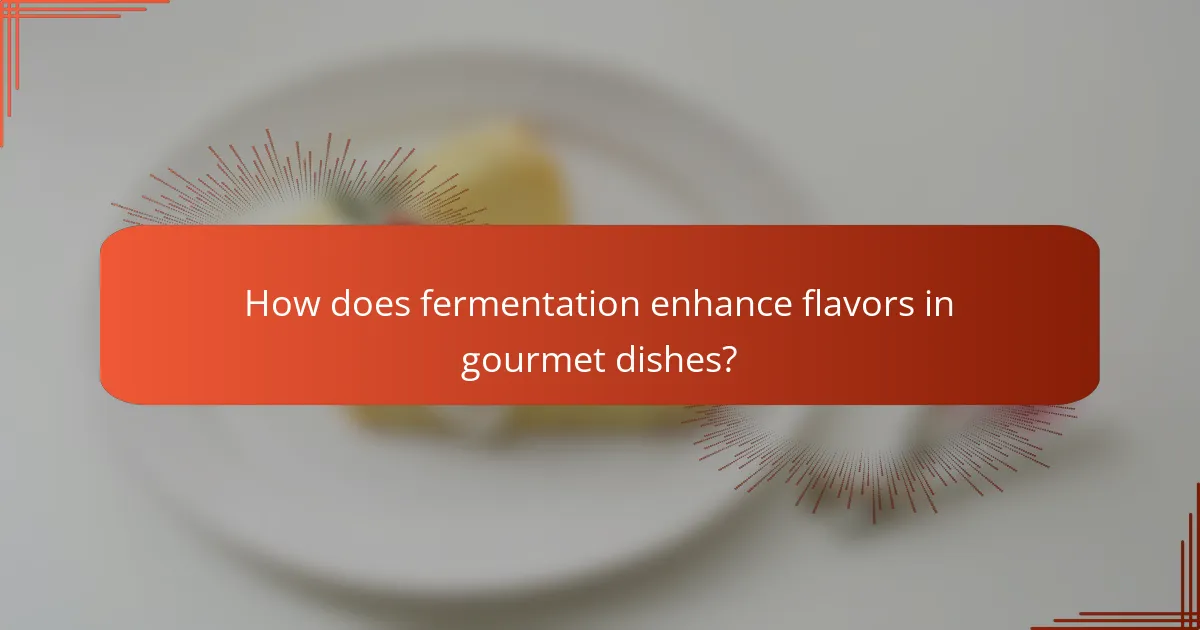Gourmet cooking techniques can transform your culinary creations, making them more flavorful and visually appealing. For beginners, mastering essential methods like sous vide, emulsification, and fermentation can significantly enhance your cooking skills and elevate your dishes. Each technique offers unique benefits, allowing you to explore the science behind cooking while achieving restaurant-quality results at home.

What gourmet cooking techniques should beginners learn?
Beginners should focus on mastering a few essential gourmet cooking techniques that enhance flavor and presentation. Key methods include sous vide cooking, emulsification, fermentation, confit, and smoking, each offering unique benefits and applications in the kitchen.
Sous vide cooking
Sous vide cooking involves sealing food in a vacuum bag and cooking it in a water bath at a precise temperature. This technique allows for even cooking and retains moisture, resulting in tender and flavorful dishes.
To get started, invest in a sous vide immersion circulator and a vacuum sealer. Common foods to try include steak, chicken, and vegetables, typically cooked for one to several hours depending on the thickness and desired doneness.
Emulsification
Emulsification is the process of combining two immiscible liquids, such as oil and vinegar, to create a stable mixture. This technique is essential for making dressings, sauces, and mayonnaise.
To emulsify effectively, start by slowly adding the oil to the vinegar while whisking vigorously. Common pitfalls include adding the oil too quickly or not whisking enough, which can lead to separation. Aim for a smooth, creamy consistency.
Fermentation
Fermentation is a natural process that transforms food through the action of microorganisms, enhancing flavor and preserving ingredients. It is commonly used for items like yogurt, sauerkraut, and kimchi.
To ferment at home, choose a suitable food and a starter culture if needed. Maintain a consistent temperature and allow time for the flavors to develop, usually from a few days to several weeks. Be mindful of hygiene to avoid unwanted bacteria.
Confit
Confit is a method of cooking food slowly in its own fat, resulting in rich flavors and tender textures. Traditionally used for meats like duck, it can also apply to vegetables.
To make confit, submerge the food in fat and cook it at a low temperature for several hours. This technique not only preserves the food but also enhances its taste. Store confit in the fat for longer shelf life.
Smoking
Smoking infuses food with a distinctive flavor by exposing it to smoke from burning wood or other materials. This technique is popular for meats, fish, and even vegetables.
For beginners, consider using a stovetop smoker or a grill with wood chips. Monitor the temperature carefully, as smoking typically requires low and slow cooking, often several hours. Experiment with different woods, such as hickory or apple, to find your preferred flavor profile.

How can beginners master sous vide cooking?
Beginners can master sous vide cooking by understanding the essential equipment, temperature control, and cooking times involved in the process. This method allows for precise temperature management, resulting in perfectly cooked meals with enhanced flavors and textures.
Essential equipment
To start sous vide cooking, you need a few key pieces of equipment. A sous vide immersion circulator is essential for heating water to the desired temperature and maintaining it consistently. Additionally, vacuum-sealable bags or high-quality resealable bags are necessary for cooking food evenly.
Some beginners may also find it helpful to invest in a container to hold the water, such as a large pot or a dedicated sous vide container. This helps in maintaining the water temperature and makes the cooking process more efficient.
Temperature control
Temperature control is crucial in sous vide cooking, as it determines the doneness of your food. Most meats can be cooked at temperatures ranging from 54°C to 70°C (130°F to 158°F), depending on your desired level of doneness. For example, steak is often cooked at around 56°C (132°F) for medium-rare.
Using an immersion circulator allows you to set and maintain the exact temperature throughout the cooking process. It’s important to use a reliable thermometer to double-check the water temperature, ensuring that it remains stable for the duration of cooking.
Cooking times
Cooking times in sous vide can vary significantly based on the type of food and its thickness. For instance, a steak may require 1 to 4 hours, while chicken breasts typically need 1 to 2 hours. The longer you cook, the more tender the meat becomes, but cooking beyond a certain point can lead to mushiness.
As a general rule, thicker cuts of meat will require longer cooking times. A good practice is to start with a shorter time and adjust based on your results and preferences. Always consult reliable sous vide cooking charts for guidance on specific foods and their recommended cooking durations.

What are the benefits of emulsification in gourmet cooking?
Emulsification in gourmet cooking offers several advantages, including improved texture, enhanced flavors, and increased stability of sauces. This technique involves combining two immiscible liquids, such as oil and water, creating a smooth and cohesive mixture that elevates dishes.
Improved texture
Emulsification creates a velvety texture that enhances the mouthfeel of sauces and dressings. By breaking down fat molecules and dispersing them evenly, emulsified mixtures become creamy and luxurious. For instance, a well-emulsified vinaigrette feels more cohesive on the palate compared to a separated one.
To achieve the best texture, use a whisk or blender to vigorously combine the ingredients. Aim for a gradual incorporation of oil into the liquid to ensure a stable emulsion. Avoid adding too much oil too quickly, as this can lead to separation.
Flavor enhancement
Emulsification enhances flavor by allowing fat-soluble compounds to blend seamlessly with water-based ingredients. This process helps to release and amplify the flavors of herbs, spices, and other seasonings. For example, an emulsified garlic aioli will have a more pronounced garlic flavor than a simple garlic dip.
To maximize flavor, consider using high-quality oils and fresh ingredients. Experiment with different emulsifiers, such as egg yolks or mustard, which can also contribute unique tastes and aromas to your dishes.
Stability of sauces
Emulsification increases the stability of sauces, preventing them from separating over time. This is particularly important for sauces that need to hold their consistency during service or storage. A stable emulsion can last for several days in the refrigerator without breaking down.
To ensure stability, incorporate emulsifiers like lecithin or xanthan gum, which help maintain the mixture’s integrity. Store emulsified sauces in airtight containers to prolong their shelf life and prevent oxidation, which can affect flavor and quality.

How does fermentation enhance flavors in gourmet dishes?
Fermentation enhances flavors in gourmet dishes by utilizing microbial processes that transform ingredients, creating complex tastes and aromas. This technique not only enriches the flavor profile but also contributes to the overall texture and preservation of food.
Microbial action
Fermentation relies on the action of microorganisms such as bacteria, yeasts, and molds. These microbes break down sugars and starches into acids, gases, and alcohol, leading to unique flavor developments. For instance, lactic acid bacteria are essential in yogurt and sauerkraut, imparting tangy notes that elevate the dish.
To achieve successful fermentation, maintaining the right temperature and time is crucial. Most fermentation processes occur at room temperature, typically ranging from 20°C to 30°C (68°F to 86°F), but specific recipes may require adjustments based on the desired outcome.
Flavor complexity
Fermentation adds layers of flavor complexity that are often difficult to achieve through cooking alone. The process can introduce umami, sourness, and even sweetness, enhancing the overall taste experience. For example, fermented foods like kimchi and miso offer a depth of flavor that complements various dishes.
Experimenting with different fermentation times can yield varying flavor profiles. Shorter fermentation may result in milder flavors, while longer fermentation often intensifies the taste. A common practice is to start with a few days and adjust based on personal preference.
Preservation
Fermentation not only enhances flavors but also acts as a preservation method, extending the shelf life of food. The acids produced during fermentation create an environment that inhibits the growth of spoilage organisms. This is why fermented products like pickles and cheeses can last much longer than their fresh counterparts.
When fermenting at home, ensure proper hygiene and use clean equipment to prevent unwanted bacteria. Storing fermented foods in airtight containers in a cool, dark place can further enhance their longevity and flavor development.

What is confit and how is it prepared?
Confit is a cooking method where food, typically meat, is slowly cooked in its own fat at a low temperature. This technique not only preserves the food but also enhances its flavor and tenderness.
Definition of confit
The term “confit” originates from the French word “confire,” meaning to preserve. Traditionally, confit involves cooking food at low temperatures, often submerged in fat, which helps to tenderize and infuse the food with rich flavors. This method is commonly associated with duck, but can be applied to various meats and vegetables.
Confit is not just a cooking technique; it is also a preservation method. When properly prepared and stored, confit can last for several weeks or even months, making it a valuable technique for extending the shelf life of ingredients.
Common ingredients
The most common ingredient for confit is duck, specifically duck legs, which are often cooked in duck fat. Other meats such as goose, pork, and even chicken can also be used, depending on personal preference and availability. Additionally, vegetables like garlic, tomatoes, and even fruits can be prepared using the confit method.
To prepare confit, you’ll need a good quality fat, typically animal fat like lard or oil, which should be enough to fully submerge the ingredients. Seasoning with salt, herbs, and spices is essential to enhance the flavor profile, and common choices include thyme, bay leaves, and black pepper.



